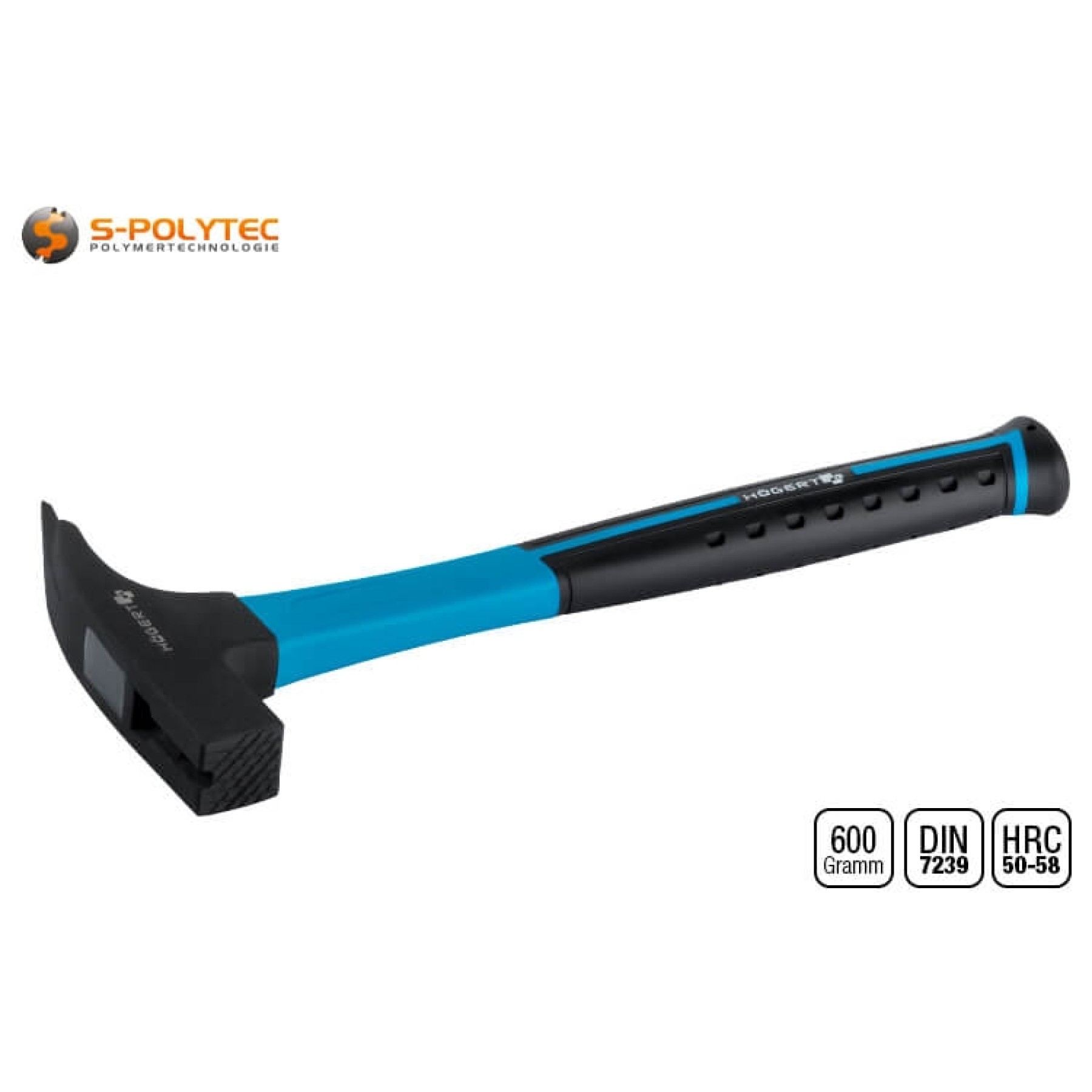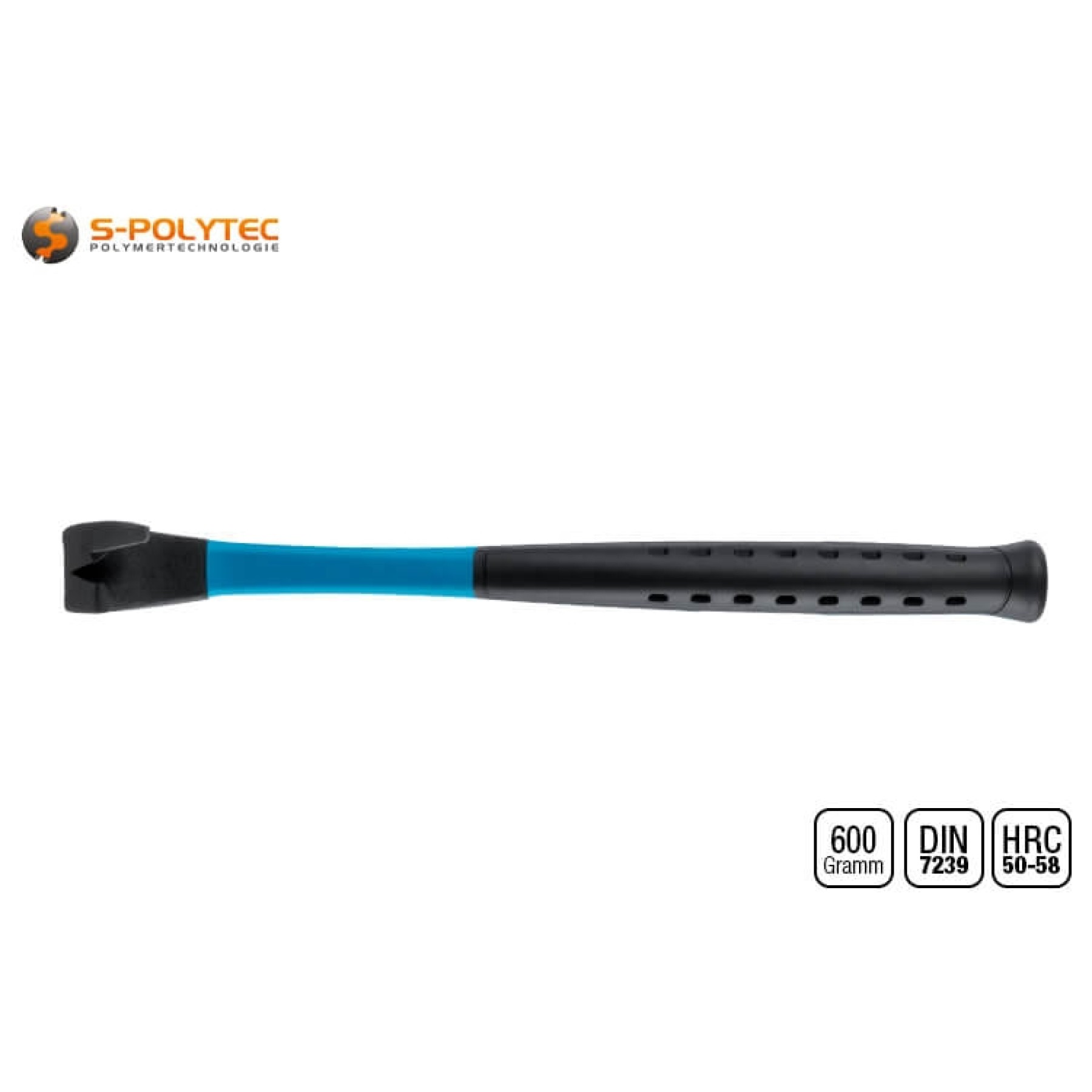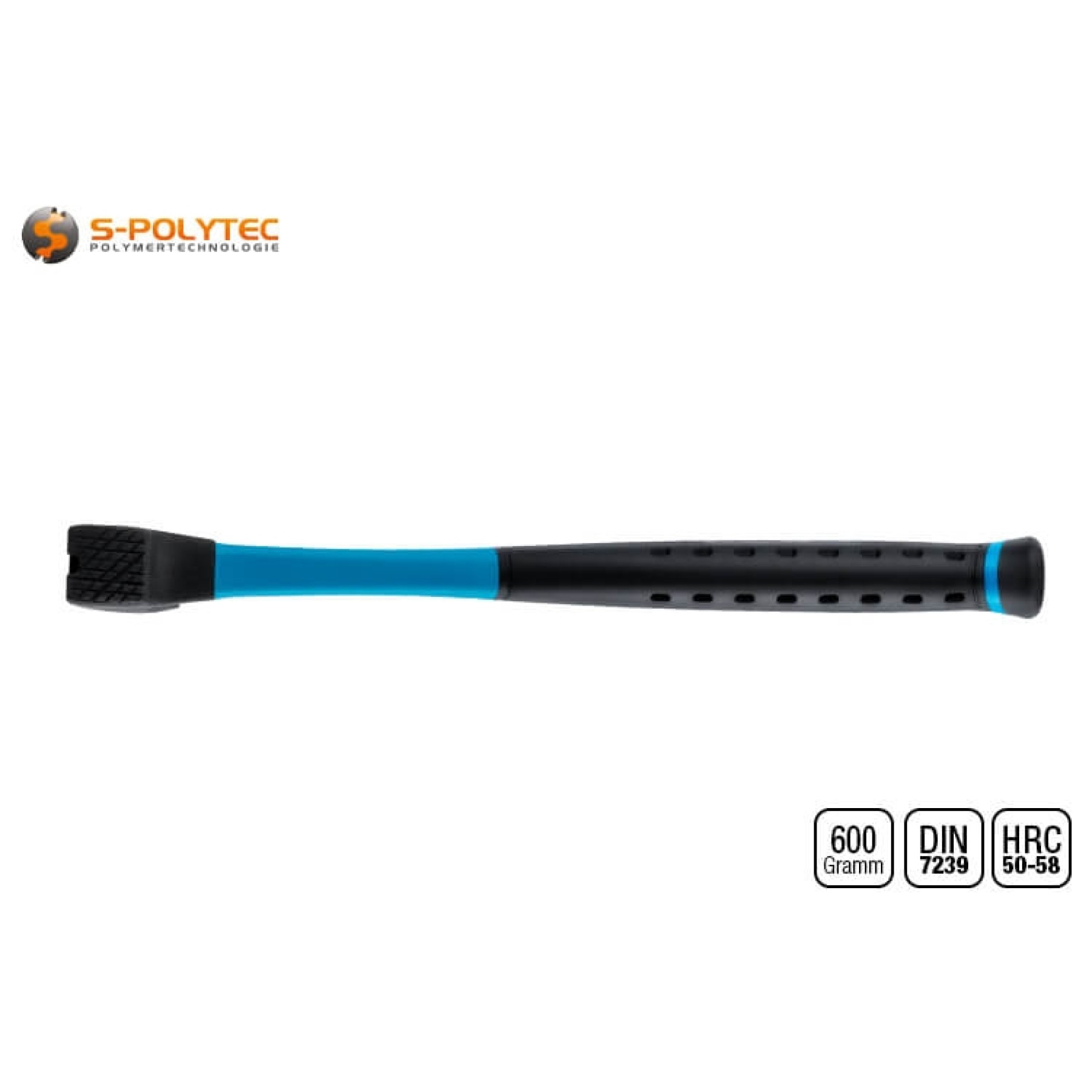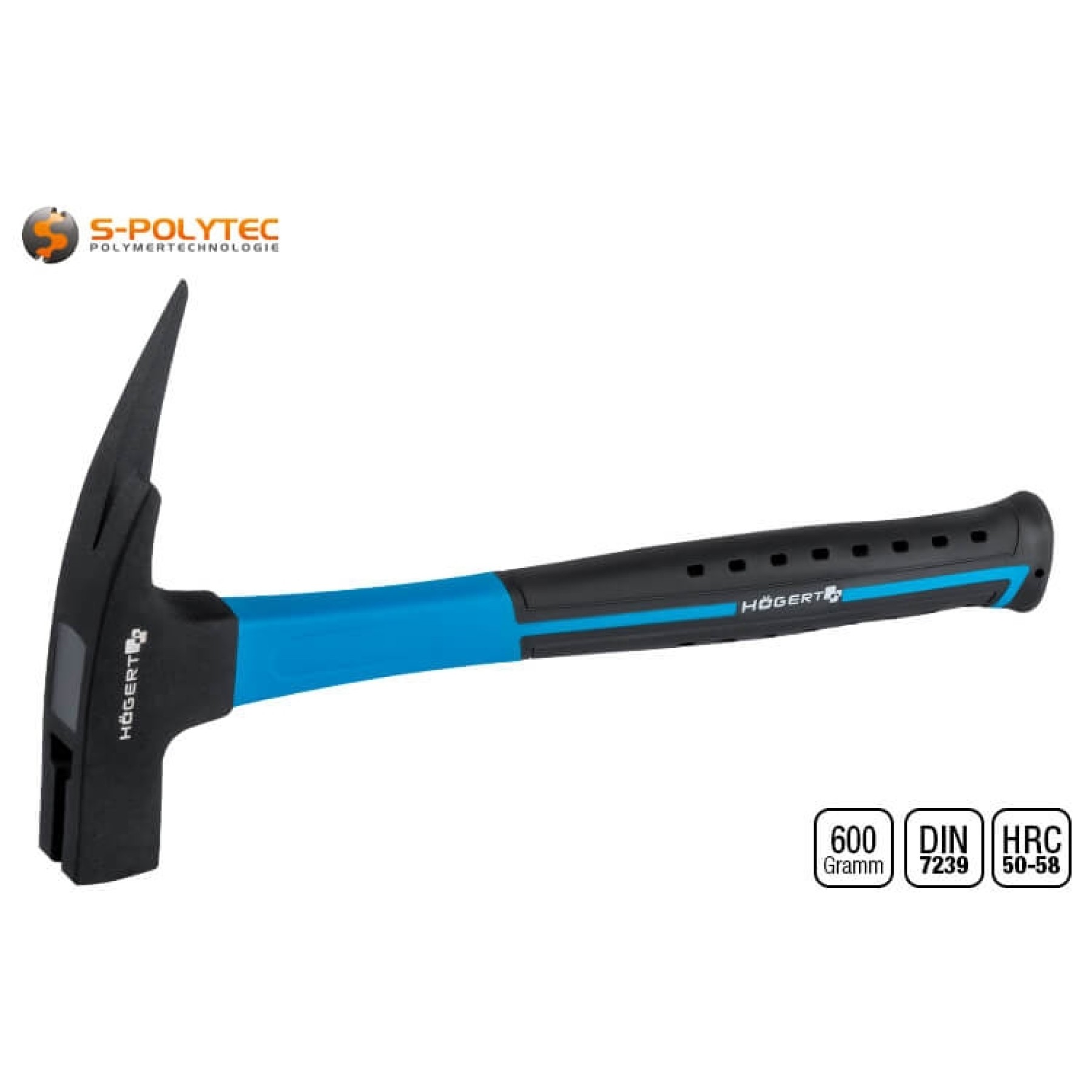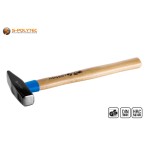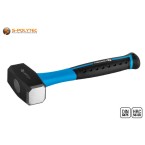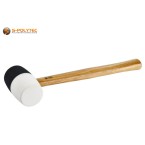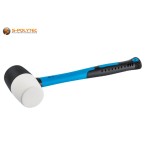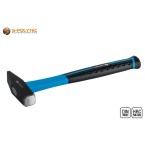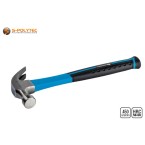
Lat hammer with fibreglass handle 600g
The Högert roofing hammer with glass fibre handle and a head weight of 600g with its elongated, pointed fin and fluted face is an extremely versatile hammer for a wide range of trades.
✓ Head forged from C45 steel
✓ Track and fin with 50-58 HRC
✓ Head shape according to DIN 7239
✓ With magnetic nail guide
✓ Vibration-damping handle
The robust fibreglass handle with rubberised grip has a shock-absorbing effect and is therefore easy on the wrists.
The item is in stock
Dispatch within 2 - 3 working days
- calculate the price
€12.90 / pc.
0,8700 kg / pc.
All prices include 19% VAT.
- Description
Lathe hammer with shock-absorbing fibreglass handle
Rubberised handle ✓ Head according to DIN 7239 ✓ Craftsman quality ✓
The Högert batten hammer with fibreglass handle and a head weight of 600 grams is a professional and extremely versatile tool that is used in particular by carpenters and roofers. It is not for nothing that the hammer with its characteristic appearance characterises the guild symbol of the roofing trade. The strong, solid head with the long drawn-out claw is manufactured in accordance with DIN 7239 and forged from high-quality carbon steel. In order to withstand the high loads at all times, the blade and claw are hardened separately, resulting in a very high hardness of 50-58HRC. The striking path is ribbed for optimum grip and also has a magnetic holder that allows the nail to be inserted and hammered in with one hand.
To ensure safe and ergonomic handling at all times, the handle is not centred in the head, but is positioned slightly closer to the solid hammer head for improved weight balance. The handle is securely and firmly connected to the rather heavy hammer head by a steel wedge. However, this alone does not make the hammer the perfect tool for craftsmen. In particular, the 2-component fibreglass construction, in which a stable fibreglass core is encased in a robust plastic, is what makes the roofing hammer stand out. This handle construction absorbs shocks and vibrations considerably. This is further enhanced by holes in the rubber coating of the grip surface arranged transversely to the handle. In addition, the rubber handle provides a firm, non-slip grip and improves working comfort thanks to its soft, pleasant feel.
Features of the roofing hammer with fibreglass handle from Högert
With a head weight of 600g, the Högert batten hammer with fibreglass handle is a powerful yet very precise tool that plays a central role in the world of building trades. Developed to meet the requirements of carpenters and builders, this hammer is characterised by its robust construction made of hardened carbon steel, high quality workmanship and versatile functionality. The typical head shape with a flat, square face and the asymmetrical, elongated claw on the other side make the roofing hammer unmistakable. The hammer, also known as a carpenter's hammer, is not only a tool for hammering in nails, but is also used for a variety of woodworking tasks. The precision and reliability of the hammer make it an indispensable companion for professional craftsmen and all DIY enthusiasts with a high level of quality awareness.
The hammer's unusual appearance has a long history and its shape and design are defined by DIN 7239. In addition to the design and dimensions for roofing hammers, this standard also defines the material and design of these hammer types, including the requirements for the minimum pull-off forces for the handle and hammer head. The latter in particular play a significant role in safe handling in the construction industry, as the hammer must be able to withstand high loads in the trade, whether it is the powerful blows when nailing thick beams or removing and straightening stuck nails with the long claw. The use of a high-strength carbon steel alloy and the additional hardening of the claw and blade result in a very high hardness of 50-58HRC. The full-surface bluing of the head is not just for an attractive appearance, but also protects the hammer from the effects of the weather.
The handle of the carpenter's hammer is solid and carefully balanced to ensure optimum handling and control. Compared to a wooden handle, the multi-component fibreglass construction results in a lighter design with improved durability and, at the same time, extremely high stability, which is particularly important for powerful blows when hammering large, long nails into battens and beams to erect roof structures or trusses. The combination of a robust fibreglass core and a hard-wearing plastic coating significantly absorbs the impact energy and thus relieves the hand and joints. The cross-holes within the grip surface also have a shock- and vibration-absorbing effect, so that no fatigue or aching wrists are noticeable even after prolonged use. The grip surface has a non-slip rubber coating with a pleasant, soft feel, which increases working comfort and contributes to a firm, secure grip on the rather heavy hammer.
Advantages of the Högert roofing hammer with fibreglass handle
- The hammer head with 600g head weight is manufactured in accordance with DIN 7239
- The head with grooved tracks and asymmetrical fin is made of carbon steel
- The fibreglass handle combines optimum stability with very high durability
- The two-component handle has a non-slip, rubberised grip surface
- The grip surface with cross holes significantly reduces shocks and vibrations
- The fibreglass handle is perfectly balanced despite the asymmetrical head geometry
- The impact path is ribbed to achieve maximum grip when hammering in the nail
- The magnetic hammer guide enables nails to be hammered in with one hand
- The ergonomic handle is perfectly matched to the head in terms of length and weight
Use and handling of a roofing hammer
The hammer head of our roofing hammer is flat on one side with a ribbed surface for maximum grip and is therefore ideal for hammering large nails into wood. On the opposite side is a sharp claw, also known as a pick, which is specially designed for removing nails and working on wooden surfaces. This dual function makes the carpenter's hammer an extremely efficient tool on the construction site. Carpenters use it when constructing wooden frames, erecting roof trusses, substructures, verandas and balcony railings made of wood and many other construction applications.
Grooved track for maximum grip
The relatively high head weight of 600 g makes the roofing hammer perfect for robust work. The comparatively high weight is particularly important for driving large, long nails through heavy beams. In order to transfer the maximum impact force to the nail head on impact and prevent it from slipping, the square track is grooved diagonally and thus offers maximum grip. What sounds banal, however, has far-reaching effects, as a nail can be sunk with fewer blows and this, in turn, primarily saves force and the time saving should not be completely disregarded. Another special feature of our roofing hammer can be seen on the top of the hammer head, where a recess has been milled into which a nail can be inserted. A powerful magnet holds the nail securely in the holder so that it can be hammered into the wood with just one hand. This minimises the risk of hitting your fingers, even if this is not the reason for the magnetic holder. In timber construction, it is often more important to align the board, batten or beam with one hand. One-handed nailing means that the hand required for this is free and no other person is needed to hold the beam.Long, pointed claw removes nails effortlessly
The long claw is a true all-rounder. Due to its long, pointed shape, it is by no means suitable for hammering in nails, but when hammered directly into the wood, the hammer is a practical aid when carrying, pulling and aligning the usually heavy beams of roof trusses. The claw is sharp and split in the centre, making it possible to grip nails precisely, which is particularly practical when they need to be corrected or removed. To make this as easy and effortless as possible, the claw is bevelled and slightly curved. It is also used for removing formwork in concrete construction. The tip is driven between the wooden formwork and the hardened concrete with a precise blow and pulled apart by the leverage effect of the long handle. The same also applies to the controlled dismantling of beam constructions, where nailed beams are to be separated from each other, either to remove them completely or to correct their position.Carpenter's hammer or roofing hammer?
The name lath hammer is derived from its traditional use for fastening laths. This is an activity carried out by carpenters during the construction of roof trusses. The roofing hammer is part of the carpenter's standard equipment, which is used not only for roof constructions but also for interior work, as well as for the construction and repair of timber framing, balconies or verandas. For this reason, the roofing hammer with its unusual head shape and asymmetrical fin with an elongated claw is also known as a carpenter's hammer. However, this does not mean that the hammer is used exclusively by carpenters in woodworking. This hammer is also very popular in concrete construction for erecting formwork or removing it once the concrete has hardened.NOTE: As with any impact tool, personal protective equipment consisting of work gloves and safety goggles is also advisable for the roofing hammer to prevent injuries from possible splinters, which cannot be ruled out due to the high impact energy.
Technical data of the Högert carpenter's hammer
- Product type: Hammer
- Material (Head): hardened C45 Steel
- Material (Handle): 2K fibreglass (rubberised)
- Head shape: Lat hammer
- DIN Norm: DIN 7239
- Weight (Head): 600g
- Shape Fin: curved, asymmetrically split
- Form railway: Square
- Area track: approx. 27mm x 27mm
- Length (handle): approx. 28.5cm
- Weight (Handle): 270g
- Length (Total): approx. 33cm
- Weight (Total): 870g
- Commercial use: Permissible
Storage and care of the roofing hammer with glass fibre handle
The roofing hammer is designed for commercial use by tradespeople and as such is extremely resistant to moisture and UV radiation. Thanks to the selected materials, the hammer is fairly undemanding in terms of ideal storage or maintenance to maintain its service life. There is no harm in occasionally wiping the hammer and handle with a cloth to remove dust and dirt to maintain the hammer's attractive appearance. Only the shock-absorbing cross-holes within the grip surface should always be kept clear, because if dust or coarse dirt collects in the holes, their shock-absorbing capacity is no longer fully guaranteed.
WARNING: Even if the elongated pointed fin tempts you to use it as a substitute for a chisel, you should never strike the head of the roofing hammer with a hammer. On the one hand, two hardened metals meet here, which means that one of the hammers will suffer and, on the other hand, this can also be very damaging for the handle fastening, as the steel wedge loosens and the head no longer has a sufficiently secure fastening.
- Additional Information
Additional Information
Product-ID LHMR600 Delivery Time Dispatch within 2 - 3 working days EAN/GTIN 5901867132253 Material Hardened C45 steel Property Head weight 600g - manufactured according to DIN 7239 Weight 0.8700 - Reviews
